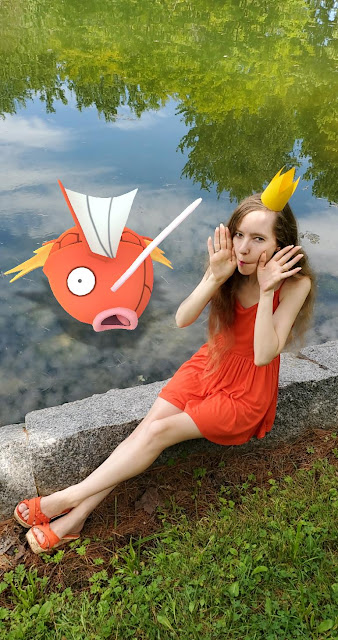Thinking about dressing up as a creepy doll for Halloween? Why not make yourself a spooky toy box prop to go along with your look? Or if you have some haunted dolls to add to your Halloween decor, perhaps they could use a spooky toy box of their own.
Creepy doll Amber emerging from her spooky toy box.
Materials:
*Large cardboard box
*Black acrylic paint
*White acrylic paint
*Red acrylic paint
*Brown acrylic paint
*Orange acrylic paint
*Wide paintbrush
*Thin paintbrush
*Removable vinyl
*Scissors or die cutting machine
*Metal brads
*Black duct tape
*Box cutter
*Water
*Paint palette (I use plastic container lids for my palettes)
Directions:
*Take your cardboard box and cut off the two shorter flaps. Set them aside, as you will need them soon.
*Next, cut off one of the longer flaps and then attach it to the remaining flap using the duct tape to create the lid of your toy box.
*To stabilize the newly formed lid, cut one of the short flaps you've cut off in half "hot dog style" (as in, instead of folding it the hot dog way, we're cutting along what would be the fold line if we were instead to fold it).
*Use duct tape to attach these segments to the inside of the lid to provide the lid with added stability. Make sure that your added cardboard segments are going across the seam in the middle of the lid, as this is likely the weak point in the lid. Depending on how stable or flimsy your lid seems after this step, you may want to cut apart the other short flap and tape it on as well.
*Using scissors or a die cutting machine, cut out the lettering for your toy box from removable vinyl.
*Affix the letters to the front face of your toy box.
*Take some black paint and add just a little bit of water, then brush it across the front face of the box. Let dry.
*Once dry, take some white paint, add a little water, and brush it over the front face of the box. Let dry.
*Take some slightly watered down black paint and brush over any places where the white is too bright.
*Paint the remaining sides and top in the same fashion, starting with some black paint, then adding white, and finally adding some black in any needed places.
*Gently peel the removable vinyl off the front face of the box. It's okay if some paint has seeped underneath the letters, as long as you can still see where you need to paint.
*Paint the letters red. You could either use plain red paint, or add a little bit of black and brown to your red paint to create a more bloody red. Let dry.
*Using a thin paintbrush, paint thin black lines to create the appearance of boards. You'll want to do this to the sides and top of the toy box.
*Tape around all the edges of the toy box with black duct tape.
*Combine orange and brown paints to create a rusty color. Paint the tops of four metal brads with this mixture. Let dry.
*Poke the brads through the corners of the front of the box to give the appearance of nails. You could do this with the other sides of the box too, although I didn't because I didn't have enough brads.
*If you're going to be opening the toy box a lot or leaving it open, you may want to paint the inside black to conceal any awkwardness in the duct tape. I didn't this time around, but if I make another one of these in the future, I will probably do that.





















